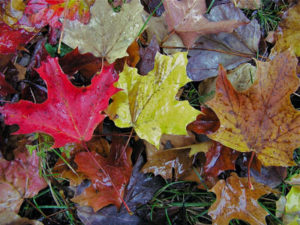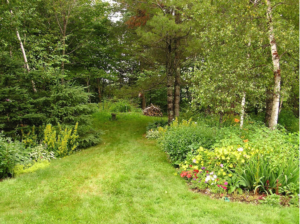
Organic Lawncare
The cool climate of Maine fosters healthy lawns. The grass will grow lush and with few problems as long as basic plant needs are met, including proper soil fertility, soil structure and soil organic matter, and proper watering, and mowing. It’s not difficult to maintain organic lawn care. In fact, you can care for your lawn organically in all seasons!
You don’t need synthetic pesticides or fertilizers for quality organic lawn care. In fact, such synthetic chemicals can pollute bodies of water and harm wildlife, from beneficial insects to fish, birds, and other wildlife. According to the Maine Board of Pesticides Control, more than 6.2 million pounds of yard care pesticides were brought into Maine in 2007 — a sevenfold increase since 1995 that coincided with an uptick of yard care companies in Maine. The trend reversed in 2011, when yard care pesticides brought into Maine dropped to 5.7 million pounds. You can help continue this downward trend by growing a lawn without using pesticides — or by hiring an organic lawn care company.
Establishing a new lawn
You can start a new lawn in Maine almost anytime between early spring and mid-September. It takes some preparation, but organic lawn care isn’t difficult.
Soil preparation
Good soil preparation is important for quick establishment of lawn grasses and further organic lawn care. The soil surface should be smooth, without humps that you’ll shave by mowing or dips that will collect water. If you remove the topsoil, you should add 6 inches of new topsoil. This equals 372 cubic yards of topsoil per quarter acre (or 34 cubic yards per 1,000 square feet). If the soil is mostly sandy, gravely, or clayey, incorporate organic matter to improve soil structure. This helps hold water and nutrients in the soil. For each 1,000 square feet of lawn, add 4 cubic yards of compost, well-rotted manure or well-rotted leaves. Aim for 5 to 7% organic matter.
Liming and fertilizing
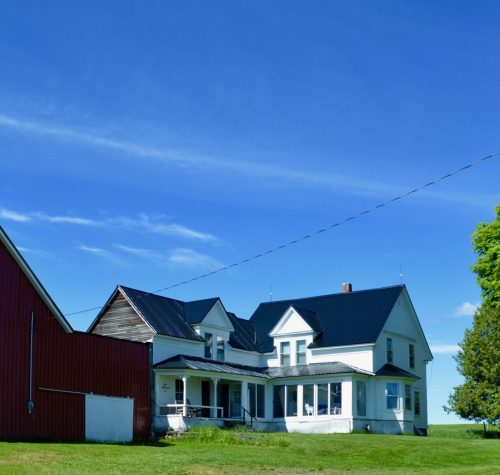
To determine lime and fertilizer needs, test your soil. Obtain a soil test kit (a small cardboard box and a paper form) from your county’s University of Maine Cooperative Extension office. Note on the form that you want organic recommendations for a lawn. Test results will come back to you with recommendations for lime and nutrient amendments. You can learn how to use organic amendments here to meet soil needs.
Nitrogen requirements can be met with compost, manure or seed meals such as soybean meal. One can meet future nitrogen requirements of established lawns by including white clover into the lawn species mix. Homeowners usually meet phosphorus and potassium needs with rock phosphate and SulPo-Mag, respectively. You can also meet calcium and magnesium needs with limestone applied when adjusting soil pH. (A pH of 6.0 to 6.5 is good for most lawns.) Also, many commercial organic fertilizers and composts are available at garden centers.
If you adjust the soil pH and fertility with organic amendments when establishing the lawn, you will rarely need to add minerals later on unless you remove them by removing grass clippings when mowing. Also, raising the soil pH to 6.0 to 6.5 will favor lawn grasses over many weeds.
Tilling
One method to mix recommended fertilizer, limestone and organic matter into the top 6 inches of soil is by plowing and rototilling. But don’t till excessively, as it may destroy soil structure.
After tilling, wait two weeks for weed seeds to germinate then till again to kill them. Plant after the second tilling unless a heavy crop of weeds emerges. In this case, wait two more weeks and till again before planting.
Seeding
Seed types
There are many grass seed types that can help make the organic lawn care process easier for you. Choose grass varieties that are adapted your site’s specific conditions; consider if the site is in the sun or shade, the amount of foot and vehicle traffic, available water and the soil type.
The three principal grasses used in the Northeast are Kentucky bluegrass, fine fescue and perennial ryegrass. Perennial ryegrass is not hardy enough to survive Maine winters but is sometimes added to grass mixtures because it starts growing quickly in the spring and offers cover to the other varieties while they get established.
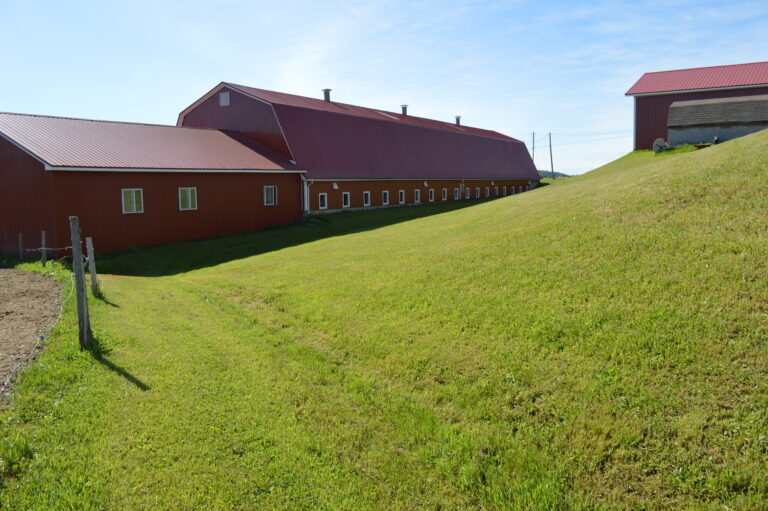
In areas receiving full sun, Kentucky bluegrass, which is best adapted to bright sunlight, should make up at least 75% of the mix.
Fine-leaved fescues tolerate shade and could make up at least 65% of a shade mix.
White clover, a legume, associates with bacteria that “fix” nitrogen from the atmosphere — i.e., they convert the abundant nitrogen gas in the atmosphere into a form plants can use. So adding white clover to a grass mix helps maintain soil fertility. Clover also stays green during moderate droughts and helps the lawn continue to look lush in dry conditions. The clover flowers also support bees and other pollinators.
Seed mixes
A general mix for a partially shaded lawn is:
- 50% Kentucky bluegrass
- 30% red fescue
- 15% perennial ryegrass
- 5% white clover
Fedco Seeds sell this combo as “CR Lawn Mix,” which is described as an “all-purpose grass seed mixture for the Northeast.”
A quality grass mix should state on the bag that the germination rate, or the average rate that seeds germinate over a week-long period, is more than 85% and that the percentage of weed seeds is near zero. It should contain little or no annual ryegrass, which greens up quickly but doesn’t overwinter and is often included in cheap seed mixes.
Endophyte-inoculated ryegrass or fescue supports a beneficial fungus that produces alkaloids. This helps reduce disease and insect infestations, increase drought resistance, and reduce fertilizer and pesticide needs. But these fungal-enhanced grasses are toxic to livestock and grazing wildlife, so do not use them where you may keep animals someday.
If an area receives less than four hours of sun, plant a shade-tolerant groundcover rather than grass, or mulch the area.
High-traffic areas need extra attention or a different surface.
How to seed your lawn
Spread 1/2 to 1 pound of grass seed mixture per 1,000 square feet; double this rate if weed seeds are abundant. If seed is sown too thickly, plants will be overcrowded and more prone to disease. If sown too thinly, weeds can invade. To distribute seed evenly, spread half in one direction, overlapping the spread by half on each pass. Then spread the second half in a direction perpendicular to the first. Be sure the seed has good contact with the soil by raking it in lightly and firming the ground with a light roller. Spread 1/4 inch of compost or weed-free hay or straw over the seed and water lightly. Water at least daily until plants have taken hold.
A lawn may take a year to become fully established.
Organic lawn care for all seasons
Caring for your lawn isn’t something that just happens in the warmer months. Organic lawn care is a year-round process. If you maintain your lawn each season, you will have a healthier lawn in the long term. Here are some steps to take care of your lawn in all seasons.
Spring organic lawn care
The first step in spring organic lawn care is to rake the lawn to remove any heavy layers of leaves and other debris. Next, seed thin or bare areas, following the seeding directions from above.
Mowing your lawn in the spring
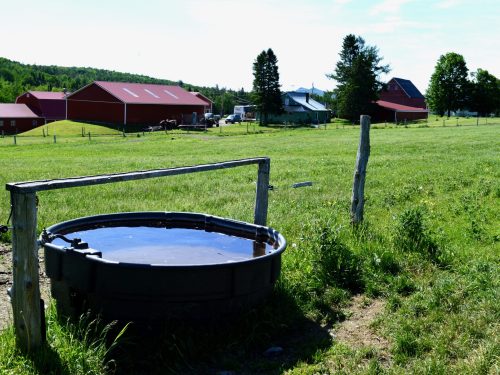
Successful organic lawn care depends on regular mowing to the correct height. Mow to a height of 2 inches for the first mowing to stimulate growth and to 3 inches or higher after that. Remove no more than one-third of the leaf surface at each mowing. Removing any more will lead to excess water loss. So, for a 2-inch target height, mow when the grass is 3 inches tall. For a 4-inch target height, mow when the grass is 6 inches tall. Longer grass blades create deeper roots, which access water and nutrients better. This reduces the need for additional water and fertilizer.
Longer grass blades also shade out weeds. In a 1-inch-tall lawn, dandelions and crabgrass establish themselves readily. But in a 2- to 2.5-inch-tall lawn, dandelions won’t germinate and crabgrass will suffer from competition.
Don’t mow so low that the meristems (growing points) of grass plants are removed. “Scalping” the grass will kill a lawn. Low mowings also weaken or kill most cool-season grasses in hot, dry weather.
Also, try to change the mowing direction each time you mow.
After you mow
Leave clippings on the lawn. They do not cause thatch, and they do recycle nutrients and organic matter. This recycling, combined with deeper rooting of taller grasses and the inclusion of clover, eliminates the need to fertilize lawns. Do not allow the grass to grow too tall, however, since excess clippings can smother a lawn. If you find that you have to mow more than once each week because your grass is growing too tall, you may have applied too much nitrogen fertilizer.
While a tall (2-1/2- to 3-inch-thick) turf is the best defense against weeds, weeds are still likely to appear here and there. Pull them by hand as they appear and before they go to seed to keep them from spreading. If weeds are extensive or a large area needs to be weeded, consider using a tool such as a small eco-weeder, which burns weeds (roots and all.) Or consider a long-handled Weed Hound, which pulls weeds.
Spring weeds
Understanding the life cycle of a weed will help with its control.
- Crabgrass is an annual that develops from seeds each year. Some of the seeds may stay in the soil for many years, waiting for an opening or thinning in the stand. Crabgrass will not tolerate shade. A sufficiently dense turf cut no shorter than 2 inches slows crabgrass growth. If crabbgrass is prevented to produce seed for two years, the supply of viable seeds in the soil will diminish dramatically.
- Chickweed may act as a winter annual, germinating in late summer, growing for a while and then becoming dormant for the winter. In spring, it resumes growth and produces seeds. Chickweed may also act as a typical summer annual. Tall grass and clover may smother it. Hand pull as soon as it appears in your lawn and before it goes to seed.
- Dandelion, a broadleaf perennial, is one of the most common weeds in North America. It is difficult to control because of its deep taproot, any part of which may sprout new leaves if left in the ground. Tall, sufficiently thick turf discourages dandelions. When pulling, use a tool to dig out the root. For a typical lawn, do not let dandelions go to seed. Note, however, that dandelions can bring diversity to a lawn, providing pollen and nectar for bees, and greens for the kitchen.
Avoid fertilizing lawns in spring, as spring fertilization promotes shoot growth at the expense of roots and promotes weed seed germination. In fact, a green lawn may be achieved without adding fertilizers or lime (and certainly without toxic synthetic pesticides.)
Summer organic lawn care
Mow your summer lawn as infrequently as possible (but often enough to remove only one-third of the growth) and with the blade set as high as possible.
Lawns rarely need watering in Maine, and MOFGA supports water conservation. When the top 2 inches of soil is dry, let the lawn go dormant (it will green up again in fall) or water deeply — once per week with 1 inch of water, or enough water to wet the top 6 inches of soil.
During or just after a light rain is a good time to irrigate, and watering in the morning is best so that foliage dries during the day. Evening or night watering can promote disease because the lawn may stay damp all night. You can measure the amount of irrigation water applied by putting a shallow container under the sprinkler to see when an inch of water has accumulated in the container. Infrequent but heavy watering promotes deeper rooting (which leads to less need for watering) and fewer disease problems than frequent, shallow watering. Frequent, shallow watering leads to weak turf that weeds will out-compete, and may also cause fungus problems.
Note that you should water new lawns whenever they become dry, and until they are well established.
If you think your lawn needs more nitrogen, do not apply it now; midsummer applications of nitrogen promote the growth of crabgrass.
Late August to early September
Check the soil pH if you haven’t done so in the past five years and add lime if necessary.
Aeration can double the rooting depth of lawns. Many garden centers rent aerators, which pull small plugs of soil from lawns. Aerate every one to three years on residential lawns, especially if they are in poor condition or get a lot of foot traffic. Aerate in the fall, when lawns are less susceptible to weeds. You should aerate intensively managed turf, such as athletic fields, several times each year.
Soil should not be too wet or dry when aerated. Water dry soils well the night before aerating. Holes should be about 6 inches deep, at a rate of about 50 to 100 per square yard. Organic lawns that aren’t used heavily will eventually be aerated by earthworms.
Reseed any bare or thin spots. Topdress with nutrients if necessary — for example, if the lawn is less than 10 years old or if a soil test indicates nutrient deficiencies.
Fertilizer recommendations for organic lawn care
Fertilize low-maintenance lawns once each year, in late August or in September (or not at all; see below). Typical organic fertilizer recommendations include:
- Nitrogen (N) – Typical recommendation: 2 pounds/1,000 square feet. Meet by leaving grass clippings in place and topdressing with 1/4 inch of compost (100 pounds or 3/4 yard per 1,000 square feet) and 11 pounds/1,000 square feet of soybean meal.
- Phosphorus (P) – Typical recommendation: 3/4 pound/1,000 square feet. Compost and soybean meal applied for nitrogen (above) will meet this phosphorus recommendation.
- Potassium (K) – Typical recommendation: 1/3 pound/1,000 square feet. Compost and soybean meal applied for nitrogen (above) plus 4 pounds/1,000 square feet of Sul-Po-Mag will meet potassium recommendations.
Once you establish the lawns, additional phosphorous and potassium are seldom needed.
Soil tests do not reliably measure nitrogen. Lawns that include clover and that have clippings returned often need no additional nitrogen. If your lawn is very dark green, you probably applied more nitrogen than necessary. Excess nitrogen can lead to excess mowing, increased incidence of disease, and risk of polluting bodies of water. A light green to yellow color indicates insufficient nitrogen, which can lead to sparse growth and bare spots.
If necessary, apply beneficial nematodes in mid to late August to control grubs, after identifying the type of grubs present. Heterorhabditis bacteriophora (Hb) are the nematodes that are most effective against Japanese beetles, European chafers and other lawn pest grubs. These nematodes are sensitive to sunlight, so apply them on a cloudy or rainy day or at dusk. They also prefer a moist environment, so if the soil is dry, add 1/2 inch of water before applying nematodes. A second application may be necessary.
Grub management for organic lawn care
Beneficial nematodes can be applied in mid to late August to control grubs, after identifying the type of grubs present. Heterorhabditis bacteriophora (Hb) are the nematodes that are most effective against Japanese beetles, European chafers and other lawn pest grubs. These nematodes are sensitive to sunlight, so apply them on a cloudy or rainy day or at dusk. They also prefer a moist environment, so if the soil is dry, add 1/2 inch of water before applying nematodes. A second application may be necessary. See more information below.
Fall organic lawn care
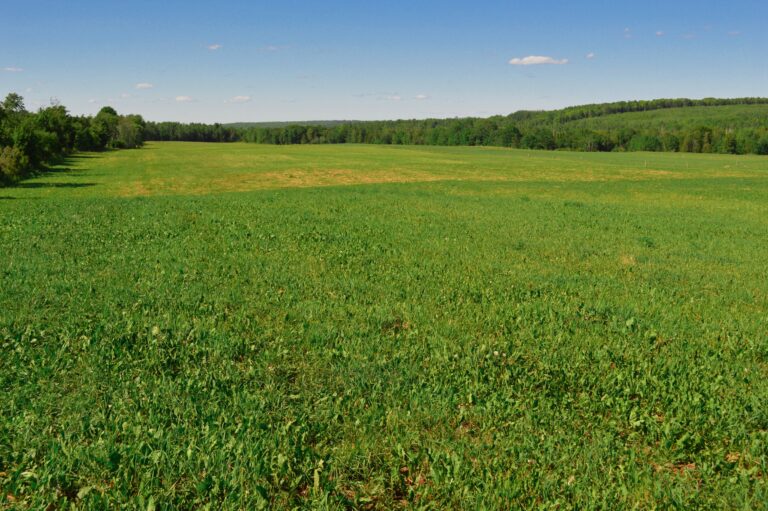
In areas where leaves accumulate in deep layers, collect and chop them after they fall from trees (e.g., with a rotary mower with a leaf catcher). You can also rake them for mulch or compost.
For the last mowing, set the blades at 2 inches to leave the grass low enough over winter to help prevent disease. Longer grass can matte, especially under snow. A 2-inch final fall mowing can also help in spring if grass begins growing while the soil is too wet for mowing.
Winter organic lawn care
Run the mower until it is out of gas before storing it for winter. Over the winter, remove the spark plug and blades, scrape grass from the blades, sharpen them and spray them with WD-40. Change the oil. Replace the spark plug and blades.
How often should you sharpen your mower blades? Professionals sharpen blades every 8 hours. Homeowners may find once per season more reasonable. Sharp blades make lawns appear neater and reduce disease susceptibility.
Managing pests
Many insects live in or on lawns, but only a few damage lawns enough to require control measures. Insects may feed on roots, stunt the grass or cause dieback, browning or bleaching of leaves. If you see symptoms, identify the pest before trying to control it. Having diverse, healthy plants in the lawn and landscape will discourage pests and will attract birds (which prey on insects) and other animals. This should be your first line of defense against pest insects.
Grubs are the major insect problem in Maine, but populations really aren’t high enough to visibly damage turf. Common grubs are the larval stage of June beetles, Japanese beetles, Asiatic garden beetles or European chafers.
A healthy, properly watered lawn can tolerate about 10 grubs or up to 30 chinch bugs (another potential lawn pest) per square foot. Beneficial nematodes are effective against grubs but must be applied according to directions in order to work. They may not survive in colder parts of Maine. Milky spore disease targets Japanese beetle grubs, but is not very effective in Maine. If you see Japanese beetles with eggs growing from their thorax, do not kill them. These beetles have been parasitized by tachinid flies. Each egg will develop into a new fly, which will parasitize more beetles, and so on.
Turf diseases are seldom serious problems in Maine. Occasionally leaf spot, brown patch or a pythium disease appears, but seldom do these justify chemical treatment. Most often, by the time the disease is identified, the weather has changed and the disease has stopped spreading. Compost can confer resistance to dollar spot, brown patch, pythium and other diseases in turf.
Additional Resources
Ask an Organic Specialist
- Ask Caleb Goossen questions about organic land management.
- Ask Heather Spalding questions about pesticide policies and ordinances related to lawn care.
